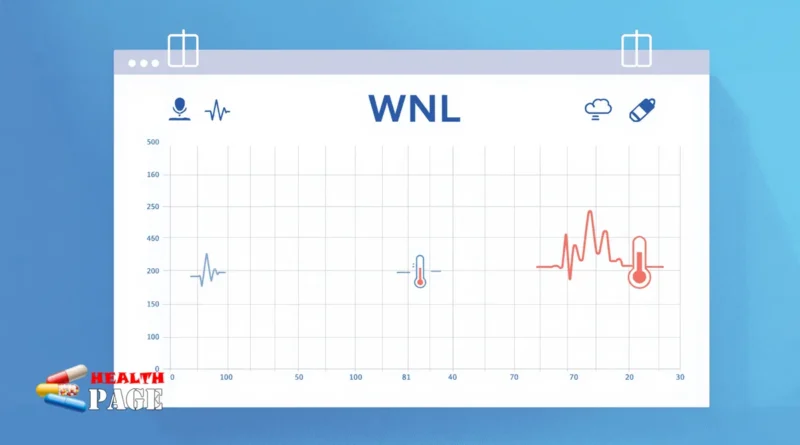7 Powerful Facts About the WNL Medical Abbreviation That Might Surprise You
Medical abbreviations are essential for effective communication in healthcare, and one of the most widely used abbreviations is WNL. This abbreviation stands for “Within Normal Limits,” which is a convenient way to indicate that test results or findings are normal.
Healthcare professionals rely on these abbreviations to efficiently document patient care. The WNL medical abbreviation can be found in numerous medical charts, lab reports, and clinical notes on a daily basis.
Understanding medical shorthand like WNL benefits both medical staff and patients:
- It speeds up medical documentation
- It reduces communication errors
- It helps patients better understand their health records
- It standardizes medical reporting across facilities
In this article, we will explore seven surprising facts about the WNL medical abbreviation:
- Its exact meaning and proper usage
- The history behind this common notation
- How doctors and nurses apply it daily
- Common tests where you might see WNL
- Why it matters for patient care
- Potential limitations to watch for
- Standards that govern its use
Join us as we delve into how this simple three-letter abbreviation influences modern healthcare delivery and enhances patient comprehension.
1. What Does WNL Mean in Medical Terminology?
WNL stands for “Within Normal Limits” in medical terminology. This abbreviation helps healthcare providers quickly note that test results or observations match expected healthy ranges.
Medical professionals use WNL to mark various health measurements:
- Vital Signs
- Blood pressure: 120/80 mmHg
- Heart rate: 60-100 beats per minute
- Body temperature: 97.8-99.1°F
- Respiratory rate: 12-20 breaths per minute
- Laboratory Tests
- Blood sugar levels
- Cholesterol readings
- White blood cell count
- Kidney function markers
A WNL notation in your medical chart signals that your results match healthy reference ranges. These ranges can differ based on age, gender, and other factors.
Here’s a practical example:
During a routine check-up, your doctor checks your blood pressure. The reading shows 118/78 mmHg. They mark it as “WNL” because it falls within the normal range of 90-120/60-80 mmHg.
Healthcare providers write WNL in:
- Patient progress notes
- Physical examination findings
- Laboratory test results
- Diagnostic imaging reports
- Nursing documentation
This shorthand saves time while maintaining clear communication between healthcare team members. It helps them quickly identify normal findings and focus on areas needing attention.
The use of WNL requires careful consideration. Medical staff must know the correct reference ranges for different tests and patient populations. They also need to document any borderline results that might need monitoring.

2. The Historical Origin and Evolution of WNL
The history of WNL dates back to the early 1900s when medical documentation started becoming standardized. Medical professionals needed quick ways to record patient information during busy rounds.
The Rise of WNL
The abbreviation gained popularity in the 1950s as healthcare facilities grew larger. Doctors and nurses needed faster ways to communicate normal test results across growing medical teams.
Shorthand Attempts
Early handwritten medical charts show various attempts at shorthand:
- “Normal limits”
- “Within limits”
- “W/in nml limits”
- “WNL”
Standardization Efforts
The 1960s brought the first standardization efforts. Medical organizations recognized the need for clear, universal abbreviations. WNL emerged as the preferred choice for indicating normal results.
Dominance of Paper Charts
Paper charts dominated healthcare until the 1980s. Doctors wrote WNL countless times each day to document:
- Physical exams
- Vital signs
- Lab results
- Patient observations
Transformation of Medical Documentation
The digital age transformed medical documentation. Electronic Health Records (EHRs) introduced in the 1990s kept WNL alive. The abbreviation proved valuable for quick data entry.
Continued Reliance on WNL
Modern healthcare systems still rely on WNL. Many EHR systems include it as a preset option for documentation. Medical staff can click a button to mark results as normal.
Interesting Facts about WNL’s Evolution
Some interesting facts about WNL’s evolution include:
- It’s one of few abbreviations that survived the transition from paper to digital records
- The meaning has stayed consistent for over 70 years
- Medical schools worldwide teach it as standard terminology
- It appears in millions of patient records daily
Inclusion in Digital Health Apps
Digital health apps now include WNL in their interfaces. Patients can see this notation in their health portals. The abbreviation bridges the gap between medical professionals and the public.
Approval by The Joint Commission
The Joint Commission maintains lists of approved medical abbreviations. WNL holds its place as an essential part of medical communication. Its simplicity and clarity ensure its continued use in modern healthcare.
3. How Healthcare Professionals Use WNL in Daily Practice
Healthcare teams rely on WNL notations across different medical scenarios. Here’s how medical professionals use this vital abbreviation in their daily work:
Regular Patient Assessments
- Vital signs documentation (blood pressure, heart rate, temperature)
- Physical examination findings
- Mental status evaluations
- Respiratory rate checks
- Neurological assessments
Clinical Documentation
- Post-operative recovery monitoring
- Emergency department triage notes
- Routine check-up reports
- Hospital admission records
- Discharge summaries
Medical professionals document WNL in electronic health records (EHRs) to streamline communication. A nurse can quickly mark multiple normal findings as WNL during rounds.
The standardized use of WNL helps reduce miscommunication risks between:
- Day and night shift staff
- Different departments
- Primary care doctors and specialists
- Healthcare facilities during patient transfers
Time-Saving Benefits
Writing “Within Normal Limits” saves precious time in busy clinical settings. A doctor can note “Lungs: WNL” instead of writing “clear breath sounds, no wheezing, normal respiratory rate.”
Digital Integration
Modern EHR systems include WNL as a preset option in dropdown menus. This feature allows quick documentation while maintaining accuracy in patient records.
Quality Assurance
Healthcare facilities use WNL documentation to:
- Track patient progress
- Monitor treatment effectiveness
- Identify changes in patient condition
- Support insurance claims
- Meet regulatory requirements
The consistent use of WNL helps create clear, efficient medical records. This standardization improves patient care coordination across healthcare teams.
4. Common Tests and Measurements Marked as WNL
Medical professionals mark various tests as WNL when results fall into expected ranges. Here are key tests where you’ll often see this notation:
Vital Signs
- Blood Pressure: 90/60 to 120/80 mmHg
- Heart Rate: 60-100 beats per minute
- Body Temperature: 97.8°F to 99°F
- Respiratory Rate: 12-20 breaths per minute
Blood Tests
- Complete Blood Count (CBC)
- Red Blood Cells: 4.5-5.5 million cells/mcL
- White Blood Cells: 4,500-11,000 cells/mcL
- Platelets: 150,000-450,000/mcL
- Hemoglobin: 13.5-17.5 g/dL
Organ Function Tests
- Liver Function Tests (LFT)
- ALT: 7-56 units/L
- AST: 10-40 units/L
- Bilirubin: 0.3-1.2 mg/dL
Metabolic Tests
- Basic Metabolic Panel
- Blood Glucose: 70-99 mg/dL
- Sodium: 135-145 mEq/L
- Potassium: 3.5-5.0 mEq/L
These ranges help doctors spot health issues early. A WNL mark means your results match healthy patterns. Each test tells a unique story about your body’s functions.
Blood tests marked WNL suggest your organs work well. Your heart pumps right when vital signs show WNL. Normal ranges change based on age, sex, and other factors.
Doctors use these ranges as guides, not strict rules. Some people stay healthy with slightly different numbers. Your doctor knows your personal health history and can explain what WNL means for you.
Regular testing helps track changes in your body. Small shifts from normal might signal early health changes. That’s why doctors compare your results to both standard ranges and your previous tests.
5. Why Understanding WNL Is Crucial for Patients and Caregivers
Understanding WNL in medical reports helps patients take control of their health journey. A “Within Normal Limits” result brings peace of mind and confirms treatment effectiveness.
Benefits for Patients
Patients can use WNL results to:
- Track their health progress over time
- Make informed decisions about lifestyle changes
- Know when to schedule follow-up appointments
- Understand their body’s response to treatments
Benefits for Caregivers
For caregivers, WNL knowledge proves vital in daily patient care. They need to spot the difference between normal and concerning results.
Key benefits for caregivers include:
- Quick identification of health changes
- Better communication with healthcare teams
- Timely medical intervention when needed
- Reduced anxiety about test results
WNL results also guide important care decisions:
- Medication adjustments
- Diet modifications
- Activity level changes
- Treatment plan updates
“WNL results act as health checkpoints, helping both patients and caregivers navigate the care journey with confidence.”
Some medical reports include visual markers:
✓ Green highlights for WNL results
❌ Red flags for abnormal findings
⚠️ Yellow warnings for borderline cases
These visual cues make result interpretation easier for non-medical individuals. They create a simple system to monitor health status.
Patients should keep a personal health record of their WNL results. This practice helps track patterns and changes over time.
Tips for tracking WNL results:
- Use health apps or digital tools
- Keep organized paper records
- Note date and time of tests
- Record any symptoms or concerns
Regular review of WNL results empowers patients and caregivers. It creates a proactive approach to health management and early problem detection.
6. Limitations and Misconceptions About the Use of WNL
The WNL abbreviation can create false security about health status. A WNL notation on a single test doesn’t mean perfect health.
Common Misconceptions About WNL:
- WNL doesn’t mean zero health issues
- Normal limits vary based on age, gender, and other factors
- Some conditions can exist with normal test results
- WNL readings might mask early disease stages
When WNL Needs Further Investigation:
- Multiple symptoms despite WNL results
- Family history of specific conditions
- Recent lifestyle or health changes
- Persistent unexplained symptoms
A blood pressure reading marked WNL might not tell the whole story. Blood pressure can fluctuate throughout the day.
Real-World Example:
A patient’s thyroid test shows WNL results, but they still experience fatigue, weight gain, and depression. These symptoms warrant additional testing despite the normal reading.
Hidden Limitations of WNL:
- Doesn’t account for individual variations
- May miss borderline results
- Can’t replace clinical judgment
- Doesn’t show trending changes
Different labs might have varying normal ranges. A result marked WNL at one facility could need attention at another.
Healthcare providers look beyond WNL markers. They consider:
- Patient symptoms
- Medical history
- Physical examination findings
- Related test results
- Risk factors
The true value of WNL lies in context. Medical professionals use it as one piece of a larger diagnostic puzzle.
A comprehensive health assessment requires more than checking WNL boxes. Each patient needs individualized evaluation and interpretation of their results.
7. The Role of Standardization in Medical Abbreviations Like WNL
Medical organizations worldwide have created strict rules for standardization medical abbreviations like WNL. The Joint Commission, a key healthcare accreditation body, maintains a list of approved medical shorthand.
These standardized abbreviations serve several key purposes:
- Prevent medical errors from misinterpretation
- Speed up documentation processes
- Enable clear communication between healthcare facilities
- Support patient safety initiatives
- Facilitate international medical collaboration
The World Health Organization (WHO) works with healthcare systems to promote accepted medical shorthand across borders. This standardization helps medical professionals provide consistent care regardless of location.
Many hospitals now use electronic health records (EHR) with built-in medical abbreviations WNL and other standard terms. These systems often include:
- Drop-down menus with approved abbreviations
- Auto-correction features for non-standard terms
- Warning alerts for prohibited abbreviations
- Quick-reference guides for medical staff
The Institute for Safe Medication Practices (ISMP) regularly updates its list of standardized medical terminology. This list helps prevent dangerous miscommunication in medication orders and clinical notes.
Healthcare facilities must train their staff on proper use of standard abbreviations. Regular updates keep medical teams current with the latest approved terminology changes.
Medical schools now teach standardized abbreviations as part of their core curriculum. This early education helps create consistency in medical documentation from the start of a healthcare career.
Digital health platforms use artificial intelligence to check for proper abbreviation usage. These systems flag non-standard terms and suggest approved alternatives to maintain documentation quality.
The push for standardization extends beyond individual facilities to entire healthcare networks. This system-wide approach creates seamless communication between:
- Primary care offices
- Specialist clinics
- Emergency departments
- Laboratory services
- Pharmacy systems
Learn more about medical abbreviation standards from The Joint Commission
Conclusion
Medical abbreviations like WNL play a vital role in healthcare communication. These shorthand notations streamline documentation and improve efficiency in medical settings.
Understanding 7 Powerful Facts About the WNL Medical Abbreviation helps both healthcare workers and patients:
- WNL creates a universal language across medical facilities
- It speeds up patient care documentation
- The abbreviation helps track health progress effectively
- It enables quick information sharing between providers
- WNL simplifies complex medical data interpretation
Patients should feel empowered to ask questions about any medical abbreviations in their records. Your health journey becomes clearer when you understand these common medical terms.
Pro tip: Keep a small notebook during medical visits to write down unfamiliar terms and ask your healthcare provider for explanations.
Medical abbreviations evolve with healthcare practices. Staying informed about these changes helps you take control of your health decisions.
Remember: Good healthcare partnerships thrive on clear communication. Don’t hesitate to seek clarification about WNL or other medical terms in your health records.
Your active participation in understanding medical terminology leads to better health outcomes. Knowledge empowers you to make informed decisions about your care.
FAQs (Frequently Asked Questions)
What does the medical abbreviation WNL stand for and mean?
WNL stands for ‘Within Normal Limits’ in medical terminology. It is used to indicate that a test result or clinical observation falls within the expected normal range, such as vital signs like blood pressure or lab results like cholesterol levels.
How did the abbreviation WNL originate and evolve in medical practice?
The abbreviation WNL was adopted in early clinical documentation to facilitate concise communication. Over time, it evolved from handwritten notes to electronic health records, reflecting the ongoing need for standardized and efficient shorthand in healthcare settings.
In what ways do healthcare professionals use WNL during daily patient care?
Doctors and nurses frequently document findings as WNL during patient assessments or reviews to indicate normal test results. This practice enhances clarity and efficiency in patient record keeping and communication among healthcare teams by using standardized abbreviations like WNL.
Which common tests and measurements are typically marked as WNL?
Tests often noted as WNL include complete blood count (CBC) parameters, liver function tests (LFT), vital signs such as blood pressure, and other lab results. These normal ranges help accurately interpret a patient’s health status.
Why is it important for patients and caregivers to understand the meaning of WNL?
Understanding WNL helps patients interpret their medical reports correctly, indicating that certain results are within normal limits. For caregivers, this knowledge is crucial to provide appropriate support or recognize when further medical attention may be necessary despite normal findings.
What are some limitations and common misconceptions about the use of WNL in medical reports?
A common misconception is that a WNL notation guarantees overall health or absence of disease. However, further investigation may be needed even if results are marked WNL, emphasizing the importance of comprehensive clinical evaluation beyond relying solely on abbreviations.


